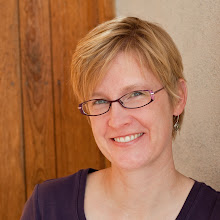I'm currently working on a lecture I have to give this Saturday and in preparation for it, I was digging through some old discs of photos looking for some images of my first tapestries. It is amazing what you can dig up on such an expedition. One thing I found on a disc labeled "July 2005 pictures to print" was images from my two weeks at
Penland School of Crafts in North Carolina. (But beware when taking such a journey. There were some other photos on that disc I would have preferred not to see again. It was a long month.)
I took a two-week color and design class from
James Koehler in the summer of 2005. I think I can safely say that that experience was life-changing. From that time, I realized that I loved weaving tapestry so much I would do it 16 hours a day and that I wanted to make contemporary art tapestries.
James, for whatever reason, wove a piece during those two weeks. It was wonderful to see him working there for the first time. Here is one of the Ensnared Light pieces coming off the loom.
These pictures are somewhat remarkable because it is the only time I saw him cut a piece off the loom. He would finish a piece in the studio while there were students and apprentices working, but he wouldn't cut it off until everyone had gone home. We would come back the next morning and find the finished and steamed piece lying on the glass-topped studio table. Sometimes it was even already hemmed. James always said he didn't like anyone else to see the piece when it first came off. And as you can see in the photo below, immediately after he cut it off, he rolled it up. I seem to remember he let us look at it in more detail the next day... after he had done some initial cleaning-up. He was not a "cut off party" kind of guy.

Oddly enough, I went to someone's house a few weeks ago on some studio business... someone I didn't know at all, and she offered to show me her James Koehler. This piece was hanging in her bedroom. It was good to meet it again 9 years later! You never know where different life paths will cross I suppose.
Here are a few other assorted photos from my weeks at Penland. If you were there or know someone who was, send them the link to this post! I'd love to hear from them. I met two of my good weaving friends, Betsy and Klaus, in this class.
As a weaving studio, we decided to participate in the auction they have during each session. The class wove this piece, and we were so pressed for time that these two were weaving at the same time! We each wove a fish and James filled in the background.
Mine was the "chili fish"... being from New Mexico and all. I think it was supposed to have an eye on it but clearly I didn't weave it in. You really have to coordinate as you change the sheds when you have two people weaving on a loom like this at the same time!
This is the Lily Loom house. The entire second floor is the weaving studio.
The class at work.
I was a lot younger then... and it was hot.
Some of the session's work hanging for discussion. I wove the tumbling triangles in the top middle and the green and orange piece to the right of it.
Penland was an inspiring place... and so was that first class with James.
By the way, if you're interested in hearing the lecture I'm giving on Saturday, it is at 9:30 am at Westminster Presbyterian Church on the corner of St. Francis and Manhattan (841 W. Manhattan) in Santa Fe. It is a lecture for the
Las Tejedoras Fiber Art Guild but they welcome anyone to their meetings.
























